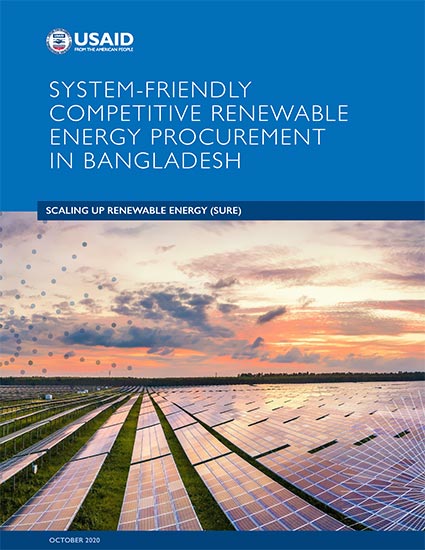- Energy Home
- How We Work
- Programs & Initiatives
- EmPOWERing Women and Girls
- Competitive Energy Procurement
- Auctions Toolkit
- Introduction
- Design
- Renewable Energy Integration
- Training
- Country Experience
- Resources
- Why Auctions?
- Designing RE Auctions
- Stages of Design
- Design Process
- Prequalification & Ceiling Prices
- Financial Guarantees & Penalties
- System-friendly Procurement
- Technology Selection
- Variable RE Forecasting
- Impact on System Operations
- System-friendly Procurement in Bangladesh
- Variable RE in Bangladesh
- Auctions Toolkit
- Toolkits
- Monitoring & Evaluation
- Resources
- Stories
Speeches Shim
The white paper analyzes design solutions for system-friendly renewable energy procurement in Bangladesh and provides recommendations on their implementation.
As auction programs mature and the share of variable renewable energy (VRE) in power systems increases, many countries find that grid integration concerns become a real barrier to scaling up renewable energy. Policymakers’ objectives often evolve from low power generation costs to enhancing dispatchability and improving the value of renewable energy. This can be accomplished by delivering renewable energy when and where it is needed and reducing integration costs.
System-friendly competitive procurement maximizes VRE’s value to the system and considers that in the award decision. The concept of system value goes beyond the power generation costs of an awarded project; it refers to a generation technology’s contribution to reducing relative system costs for electricity supply.
Expanding the Share of VRE in Bangladesh
Before the COVID-19 pandemic, forecasts pointed to increasing demand for electricity in Bangladesh resulting from economic and population growth. Expanding the share of VRE in its power system would allow Bangladesh to diversify its power mix and reduce the risks associated with volatile prices of fossil fuels, as well as the negative environmental impacts of thermal power generation. However, renewable energy’s inherent characteristics can affect the power system’s supply adequacy, the requirement for balancing services, and the need for grid infrastructure upgrades or extensions.
There is a mismatch between when renewable energy is generated and when there is peak demand for electricity, especially during the summer months. This temporal mismatch has led to load shedding, which is the deliberate shutdown of electric power to prevent the failure of the entire system when the demand strains the capacity of the system. Furthermore, the intermittency of VRE generation increases the need for flexible sources that can balance supply and demand at a moment’s notice, when clouds cover the sun or the wind stops blowing. Bangladesh’s power system has limited measures in place to ensure such flexibility.
In addition to temporal mismatch and VRE intermittency, there is also a spatial mismatch. Renewable energy projects are typically in remote locations, away from the grid and cities and towns where power demand is concentrated. In Bangladesh, future renewable energy project development will likely be in the southern and southeastern coastal areas, which may put pressure on the government to upgrade and expand grid infrastructure.
Design Solutions for System-Friendly Renewable Energy Procurement
Policymakers can use design solutions for system-friendly renewable energy procurement to reduce temporal mismatch, spatial mismatch, and VRE intermittency. System-friendly design solutions include the following:
- Time-based incentives support renewable energy generation that more closely matches the power demand curve.
- Location-based incentives steer the location of projects to specific areas and grid connection points to avoid the concentration of projects in areas that are resource-rich but too remote to be cost-effective.
- Physical hybrids combine technologies such as wind and solar installations (and potentially storage) to offset the technology-specific intermittencies of VRE and allow for more efficient use of land and transmission capacity.
- Virtual hybrids, or aggregators, bundle different power system units at different grid connection points (e.g., dispatchable and non-dispatchable renewable energy, demand response resources, storage); units are dispatched via virtual control systems.
The various design solutions differ in terms of their suitability to address Bangladesh’s system challenges, which result from the timing, location, and quality of VRE electricity injected into the grid, as well as their feasibility of implementation.
Applicability of System-Friendly Procurement in Bangladesh
System-friendly procurement of renewables increases system resilience and flexibility, reduces system costs for utilities and end-consumers, and provides Bangladesh with energy sources that are less exposed to volatility in global fuel prices. These procurements can reduce the need for dispatchable conventional power plants to meet future peak demand and therefore ensure the adequacy of the system, reducing the need for balancing services and grid infrastructure upgrades or extensions.
Recommendations
The white paper concludes with recommendations and brief action items for procuring institutions and other relevant power sector stakeholders in Bangladesh.
- Improve site selection and pre-development of site-specific auctions to address grid and land constraints (location-based incentives);
- Consider tender documents such as tariff adjustments or supply blocks to promote a more dispatchable supply (time-based incentives);
- Explore the potential to auction solar-wind hybrids; and
- Enhance power system flexibility beyond competitive procurement design to support the integration of VRE.



Comment
Make a general inquiry or suggest an improvement.